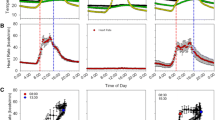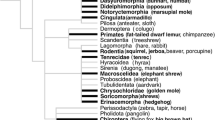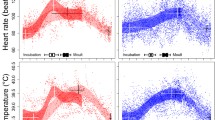Summary
The metabolic and cardiac responses to temperature were studied in two species (four subspecies) of western chipmunks (genusEutamias), inhabiting boreal and alpine environments. A specially designed (Fig. 1) implantable biopential radiotransmitter was used to measure heart rate in unrestrained animals. The estimated basal metabolic rates (EBMR) were 1.78 (E. minimus borealis), 1.64 (E. m. oreocetes), 1.50 (E. m. operarius), and 1.69 ml O2 g−1 h−1 (E. amoenus luteiventris), or 839, 752, 698, and 628 ml O2 kg−0.75 h−1, respectively, for the four subspecies (Table 1). The two alpine species (E.m.or. andE.m.op.) had significantly lower EBMR than both of their boreal counterparts. The EBMR from all animals are 120–135% of the predicted values based on body weights of the animals. The thermal neutral zone for the four subspecies ranged from 23.5 to 32°C and the minimum thermal conductances were 0.113, 0.111, 0.112 and 0.112 ml O2 g−1 h−1 °C−1, respectively, or 54.4, 54.0, 50.4 and 52.1 ml O2 kg−0.75 h−1 °C−1, respectively (Fig. 2). No interspecific diffence in conductance was observed. These values are 72 to 85% of their weight specific values. The body temperature ranged between 35.0 and 39.5°C and was usually maintained between 36 and 38°C in all subspecies between ambient temperatures of 3 and 32°C. The estimated basal heart rates were 273, 296, 273 and 264 beats/min, respectively, for the four subspecies, 49–55% of their predicted weight specific values. The resultant oxygen pulses (metabolic rate/heart rate) were 5.49, 4.50, 4.48 and 5.56×10−3 ml O2/beat, respectively, which are 2 to 2.4 times their weight specific values (Table 2).
The observed reduction of basal heart rate without the corresponding decreases of basal metabolic rate and body temperature indicate sufficient compensatory increases in stroke volume and/or A-V oxygen difference at rest. Such cardiovascular modifications provide extra reserves when demand for aerobic metabolism rises during bursts of activity typically observed in the western chipmunk.
Similar content being viewed by others
Abbreviations
- A-V:
-
arterio-venous
- EBMR:
-
estimated basal metabolic rate (ml O2 g−1 h−1)
- HR:
-
heart rate (beats/min)
- MR:
-
metabolic rate (ml O2 g−1 h−1)
- OP:
-
oxygen pulse (ml O2/heart beat)
- Ta, Tb :
-
ambient and body temperature (°C)
References
Altman, P. L., Dittmer, D. S. (eds.): Biology data book. Washington: Fed. Amer. Soc. Exp. Biol. 1966
Armstrong, D.: Distribution of mammals in Colorado. Monogr. Mus. Nat. Hist., Univ. Kansas, No. 3 (1972)
Bard, P. (ed.): Medical physiology, 11th ed., p. 1339. St. Louis: C. V. Mosby Co. 1961
Bartels, H.: Some aspects of circulatory and respiratory functions in mammals. Amer. Heart J.72, 1–6 (1966)
Bartholomew, G. A., Tucker, V. A.: Control of changes in body temperature, metabolism, and circulation by the agamid lizard,Amphibolurus barbatus. Physiol. Zool.31, 199–218 (1963)
Berkson, J.: Blood cell count: error. In: Medical physics O. Glasser, ed.), p. 110–116. Chicago, Ill.: The Year Book Publishers Inc. 1944
Black, C. C.: A review of the North American tertiarySciuridae. Bull. Mus. Comp. Zool. Harvard Univ.130, 111–248 (1963)
Brown, J. H.: Species diversity of seed-eating desert rodents in sand dune habitats. Ecology54, 775–787 (1973)
Brown, J. H., Lieberman, G. A.: Resource utilization and coexistence of seed-eating desert rodents. Ecology54, 788–799 (1973)
Dawe, A. R.: The comparative electrocardiography of small mammals. Ph.D. Thesis, University of Wisconsin (1953)
Depocas, F., Hart, J.S.: Use of the Pauling oxygen analyzer for measurement of oxygen consumption in open circuit systems and in a short-lag closed-circuit apparatus. J. Appl. Physiol.10, 388–392 (1957)
Hall, E. R., Kelson, H. R.: The mammals of North America, p. 546. New York: The Ronald Press 1959
Heller, H. C.: Altitudinal zonation of chipmunks (Eutamias): interspecific aggression. Ecology52, 312–319 (1971)
Heller, H. C., Gates D. M.: Altitudinal zonation of chipmunks (Eutamias): energy budgets. Ecology52, 424–433 (1971)
Herreid, C. F. II, Kessler, B.: The thermal conductance in birds and mammals. Comp. Biochem. Physiol.21, 405–414 (1967)
Kleiber, M.: The fire of life, p. 454. New York: Wiley 1961
Kleiber, M.: Body size, conductance for animal heat flow and Newton's law of cooling. J. Theoret. Biol.37, 139–150 (1972)
Mackay, R. S.: Bio-medical telemetry, p. 533. New York: Wiley 1970
McNab, E. K.: The metabolism of fossorial rodents: a study of convergence. Ecology47, 712–733 (1966)
Morhardt, J. E., Morhardt, S. S.: Correlations between heart rate and oxygen consumption in rodents. Amer. J. Physiol.221, 1580–1586 (1971)
Morhardt, J. E.: Temperature transmission from biopotential radio telemetry transmitters. J. Appl. Physiol.33, 397–399 (1972)
Morrison, P. R., Ryser, F. A.: Temperature and metabolism in some Wisconsin mammals. Fed. Proc.10, 93–94 (1951)
Morrison, P. R., Ryser, F. A., Dawe, A. R.: Studies on the physiology of the masked shrewSorex cinereus. Physiol. Zool.32, 256–271 (1959)
Scholander, P. F., Walters, V., Hock, R., Irving, L.: Body insulation of some arctic and tropical mammals and birds. Biol. Bull.99, 225–236 (1950)
Scott, I. M., Yousef, M. K., Bradley, W. G.: Body fat content and metabolic rate of rodents: Desert and Mountain. Proc. Soc. exp. Biol. (N.Y.)141, 818–821 (1972)
Smith, R.: Demography of the Little Northern Chipmunk.Eutamias borealis (Allen) near Heart Lake, Northwest Territories. Ph. D. Thesis, University of Alberta, Edmonton, Alberta (1974)
Sokal, R. R., Rohlf, F. J.: Biometry, p. 776. San Francisco: Freeman and Co. 1969
Spector, W. S. (ed.): Handbook of biological data, Philadelphia: Saunders 1956
Stahl, W. R.: Scaling of respiratory variables in mammals. J. Appl. Physiol.22, 453–460 (1967)
Steel, R. G. D., Torrie, T. H.: Principles and procedures of statistics, p. 481. New York: McGraw-Hill 1960
Wang, L. C.-H., Hudson, J. W.: Temperature regulation in normothermic and hibernating eastern chipmunk,Tamias striatus. Comp. Biochem. Physiol.38, 59–90 (1971)
Weinberg, G. H., Schumaker, J. A.: Statistics and intuitive approach. p. 362. Belmont: Brooks/Cole Pub. Co. 1969
Wunder, B. A.: Energetics of running activity in Merriam's chipmunk,Eutamias merriami. Comp. Biochem. Physiol.33, 821–836 (1970)
Author information
Authors and Affiliations
Rights and permissions
About this article
Cite this article
Jones, D.L., Wang, L.C.H. Metabolic and cardiovascular adaptations in the western chipmunks, genusEutamias . J Comp Physiol B 105, 219–231 (1976). https://doi.org/10.1007/BF00691124
Received:
Issue Date:
DOI: https://doi.org/10.1007/BF00691124




